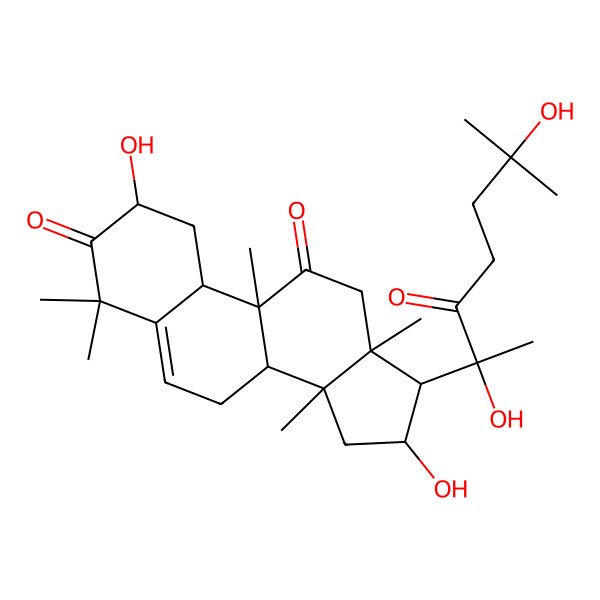23,24-dihydrocucurbitacin D
| Internal ID | cb5744f3-3871-4e65-a43a-857e3f26c70d |
| Taxonomy | Lipids and lipid-like molecules > Steroids and steroid derivatives > Cucurbitacins |
| IUPAC Name | (2S,8S,9R,10R,13R,14S,16R,17R)-17-[(2R)-2,6-dihydroxy-6-methyl-3-oxoheptan-2-yl]-2,16-dihydroxy-4,4,9,13,14-pentamethyl-2,7,8,10,12,15,16,17-octahydro-1H-cyclopenta[a]phenanthrene-3,11-dione |
| SMILES (Canonical) | CC1(C2=CCC3C4(CC(C(C4(CC(=O)C3(C2CC(C1=O)O)C)C)C(C)(C(=O)CCC(C)(C)O)O)O)C)C |
| SMILES (Isomeric) | C[C@@]12C[C@H]([C@@H]([C@]1(CC(=O)[C@@]3([C@H]2CC=C4[C@H]3C[C@@H](C(=O)C4(C)C)O)C)C)[C@](C)(C(=O)CCC(C)(C)O)O)O |
| InChI | InChI=1S/C30H46O7/c1-25(2,36)12-11-21(33)30(8,37)23-19(32)14-27(5)20-10-9-16-17(13-18(31)24(35)26(16,3)4)29(20,7)22(34)15-28(23,27)6/h9,17-20,23,31-32,36-37H,10-15H2,1-8H3/t17-,18+,19-,20+,23+,27+,28-,29+,30+/m1/s1 |
| InChI Key | ITMUUFDDBRYVNJ-VOKXYEOFSA-N |
| Popularity | 7 references in papers |
| Molecular Formula | C30H46O7 |
| Molecular Weight | 518.70 g/mol |
| Exact Mass | 518.32435380 g/mol |
| Topological Polar Surface Area (TPSA) | 132.00 Ų |
| XlogP | 2.10 |
| 23,24-dihydrocucurbitacin D |
| 55903-92-9 |
| CHEBI:62218 |
| (2S,8S,9R,10R,13R,14S,16R,17R)-17-[(2R)-2,6-dihydroxy-6-methyl-3-oxoheptan-2-yl]-2,16-dihydroxy-4,4,9,13,14-pentamethyl-2,7,8,10,12,15,16,17-octahydro-1H-cyclopenta[a]phenanthrene-3,11-dione |
| Tetrahydrocucurbitacin I |
| Dihydrocucurbitacin D |
| 2beta,16alpha,20,25-tetrahydroxy-10alpha-cucurbit-5-ene-3,11,22-trione |
| 2beta,16alpha,20,25- tetrahydroxy-9beta-methyl-19-nor-10alpha-lanost-5-ene-3,11,22-trione |
| (2S,4R)-2,16,20,25-tetrahydroxy-9beta,10,14-trimethyl-4,9-cyclo-9,10-seco-16alpha-cholest-5-ene-1,11,22-trione |
| CHEMBL564629 |
| There are more than 10 synonyms. If you wish to see them all click here. |

| Target | Value | Probability (raw) | Probability (%) |
|---|---|---|---|
| No predicted properties yet! | |||
Proven Targets:
| CHEMBL ID | UniProt ID | Name | Min activity | Assay type | Source |
|---|---|---|---|---|---|
| No proven targets yet! | |||||
Predicted Targets (via Super-PRED):
| CHEMBL ID | UniProt ID | Name | Probability | Model accuracy |
|---|---|---|---|---|
| CHEMBL253 | P34972 | Cannabinoid CB2 receptor | 97.04% | 97.25% |
| CHEMBL5619 | P27695 | DNA-(apurinic or apyrimidinic site) lyase | 96.66% | 91.11% |
| CHEMBL3137262 | O60341 | LSD1/CoREST complex | 95.98% | 97.09% |
| CHEMBL3251 | P19838 | Nuclear factor NF-kappa-B p105 subunit | 94.70% | 96.09% |
| CHEMBL2581 | P07339 | Cathepsin D | 91.41% | 98.95% |
| CHEMBL4203 | Q9HAZ1 | Dual specificity protein kinase CLK4 | 88.90% | 94.45% |
| CHEMBL2996 | Q05655 | Protein kinase C delta | 88.31% | 97.79% |
| CHEMBL3108638 | O15164 | Transcription intermediary factor 1-alpha | 87.37% | 95.56% |
| CHEMBL4208 | P20618 | Proteasome component C5 | 85.02% | 90.00% |
| CHEMBL4793 | Q86TI2 | Dipeptidyl peptidase IX | 84.88% | 96.95% |
| CHEMBL4261 | Q16665 | Hypoxia-inducible factor 1 alpha | 82.55% | 85.14% |
| CHEMBL4026 | P40763 | Signal transducer and activator of transcription 3 | 82.54% | 82.69% |
| CHEMBL1994 | P08235 | Mineralocorticoid receptor | 82.08% | 100.00% |
| CHEMBL1293249 | Q13887 | Kruppel-like factor 5 | 81.37% | 86.33% |
| CHEMBL4303 | P08238 | Heat shock protein HSP 90-beta | 81.14% | 96.77% |
| CHEMBL3038477 | P67870 | Casein kinase II alpha/beta | 81.09% | 99.23% |
Below are displayed all the plants proven (via scientific papers) to contain this
compound!
To see more specific details click the taxa you are interested in.
To see more specific details click the taxa you are interested in.
| Begonia heracleifolia |
| Bryonia cretica |
| Cayaponia tayuya |
| Cucumis melo |
| Dendrosicyos socotrana |
| Ecballium elaterium |
| Neoalsomitra clavigera |
| Trichosanthes tricuspidata |
| Wilbrandia ebracteata |
| PubChem | 180535 |
| LOTUS | LTS0206024 |
| wikiData | Q27131691 |